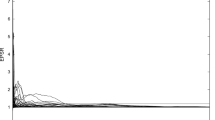Abstract
Structural equation models (SEMs) with latent variables are widely useful for sparse covariance structure modeling and for inferring relationships among latent variables. Bayesian SEMs are appealing in allowing for the incorporation of prior information and in providing exact posterior distributions of unknowns, including the latent variables. In this article, we propose a broad class of semiparametric Bayesian SEMs, which allow mixed categorical and continuous manifest variables while also allowing the latent variables to have unknown distributions. In order to include typical identifiability restrictions on the latent variable distributions, we rely on centered Dirichlet process (CDP) and CDP mixture (CDPM) models. The CDP will induce a latent class model with an unknown number of classes, while the CDPM will induce a latent trait model with unknown densities for the latent traits. A simple and efficient Markov chain Monte Carlo algorithm is developed for posterior computation, and the methods are illustrated using simulated examples, and several applications.
Similar content being viewed by others
References
Ansari, A., & Iyengar, R. (2006). Semiparametric Thurstonian models for recurrent choice: a Bayesian analysis. Psychometrika, 71, 631–657.
Blackwell, D., & MacQueen, J.B. (1973). Ferguson distribution via Polya Urn schmes. Annals of Statistics, 2, 353–355.
Bollen, K.A. (1989). Structural equations with latent variables. New York: Wiley.
Brown, E.R., & Ibrahim, J.G. (2003). A Bayesian semiparametric joint hierarchical model for longitudinal and survival data. Biometrics, 59, 221–228.
Burr, D., & Doss, H. (2005). A Bayesian semiparametric model for random-effects meta-analysis. Journal of the American Statistical Association, 100, 242–251.
Bush, C.A., & MacEachern, S.N. (1996). A semiparametric Bayesian model for randomised block designs. Biometrika, 83, 275–285.
Dunson, D.B. (2006). Bayesian dynamic modeling of latent trait distributions. Biostatistics, 7, 551–568.
Escobar, M.D., & West, M. (1995). Bayesian density estimation and inference using mixtures. Journal of the American Statistical Association, 90, 577–588.
Fahrmeir, L., & Raach, A. (2007). A Bayesian semiparametric latent variable model for mixed responses. Psychometrika, 72, 327–346.
Ferguson, T.S. (1973). A Bayesian analysis of some nonparametric problems. Annals of Statistics, 2, 209–230.
Ferguson, T.S. (1974). Prior distributions on spaces of probability measures. Annals of Statistics, 2, 615–629.
Fokoue, E. (2005). Mixtures of factor analyzers: an extension with covariates. Journal of Multivariate Analysis, 95, 370–384.
Fokoue, E., & Titterington, D.M. (2003). Mixtures of factor analysers: Bayesian estimation and inference by stochastic simulation. Machine Learning, 50, 73–94.
Gelman, A. (2004). Parameterization and Bayesian modeling. Journal of the American Statistical Association, 99, 537–545.
Ghosh, J., & Dunson, D.B. (2009). Default priors and efficient posterior computation in Bayesian factor analysis. Journal of Computational and Graphical Statistics, 18, 306–320
Ishwaran, H., & James, L.F. (2001) Gibbs samplling methods for stickbreaking priors. Journal of the American Statistical Association, 96, 161–173.
Ishwaran, H., & Takahara, G. (2002). Independent and identically distributed Monte Carlo algorithms for semiparametric linear mixed models. Journal of the American Statistical Association, 97, 1154–1166.
Jedidi, K., Jagpal, H.S., & DeSarbo, W.S. (1997). Finite-mixture structural equation models for response-based segmentation and unobserved heterogeneity. Marketing Science, 16, 39–59.
Jöreskog, K.G., & Sörbom, D. (1986). Lisrel VI: Analysis of linear structural relationships by maximum likelihood, instrumental variables, and least squares methods. Mooresville: Scientific Software.
Kleinman, K.P., & Ibrahim, J.G. (1998). A semiparametric Bayesian approach to the random effects model. Biometrics, 54, 921–938.
Lee, S.Y., & Xia, Y.M. (2006). Maximum likelihood methods in treating outliers and symmetrically heavy-tailed distributions for nonlinear structural equation models with missing data. Psychometrika, 71, 565–585.
Lee, S.Y., Lu, B., & Song, X.Y. (2008). Semiparametric Bayesian analysis of structural equation models with fixed covariates. Statistics in Medicine, 27, 2341–2360.
Li, Y., Müller, P., & Lin, X. (in press). Center-adjusted inference for a nonparametric Bayesian random effect distribution. Statistica Sinica.
Liu, C.H., Rubin, D.B., & Wu, Y.N. (1998). Parameter expansion to accelerate EM: the PX-EM algorithm. Biometrika, 85, 755–770.
Liu, J.S., & Wu, Y.N. (1999). Parameter expansion for data augmentation. Journal of the American Statistical Association, 94, 1264–1274.
Lubke, G.H., & Muthén, B. (2005). Investigating population heterogeneity with factor mixture models. Psychological Methods, 10, 21–39.
McLachlan, G.J., Bean, R.W., & Jones, L.B.T. (2007). Extension of the mixture of factor analyzers model to incorporate the multivariate t-distribution. Computational Statistics & Data Analysis, 51, 5327–5338.
Müller, P., & Rosner, G.L. (1997). A Bayesian population model with hierarchical mixture priors applied to blood count data. Journal of the American Statistical Association, 92, 1279–1292.
Ohlssen, D.I., Sharples, L.D., & Spiegelhalter, D.J. (2007). Flexible random-effects models using Bayesian semi-parametric models: applications to institutional comparisons. Statistics in Medicine, 26, 2088–2112.
Palomo, J., Dunson, D.B., & Bollen, K.A. (2007). Bayesian structural equation modeling. In S.-Y. Lee (Ed.), Handbook of latent variable and related methods (pp. 163–188). Amsterdam: Elsevier.
Papaspiliopoulos, O., & Roberts, G.O. (2008). Retrospective Markov chain Monte Carlo methods for Dirichlet process hierarchical models. Biometrika, 95, 169–186.
Sethuraman, J. (1994). A constructive definition of the Dirichlet process. Statistica Sinica, 4, 639–650.
Zhu, H.T., & Lee, S.Y. (2001). A Bayesian analysis of finite mixtures in the LISREL model. Psychometrika, 66, 133–152.
Walle, F. (1980). Education and the demographic transition in Switzerland. Population and Development Review, 3, 463–472.
Yang, M., Dunson, D.B., & Baird, D. (2010). Semiparametric Bayes hierarchical models with mean and variance constraints. Computational Statistics & Data Analysis, 54, 2172–2186.
Author information
Authors and Affiliations
Corresponding author
Rights and permissions
About this article
Cite this article
Yang, M., Dunson, D.B. Bayesian Semiparametric Structural Equation Models with Latent Variables. Psychometrika 75, 675–693 (2010). https://doi.org/10.1007/s11336-010-9174-4
Received:
Revised:
Published:
Issue Date:
DOI: https://doi.org/10.1007/s11336-010-9174-4




